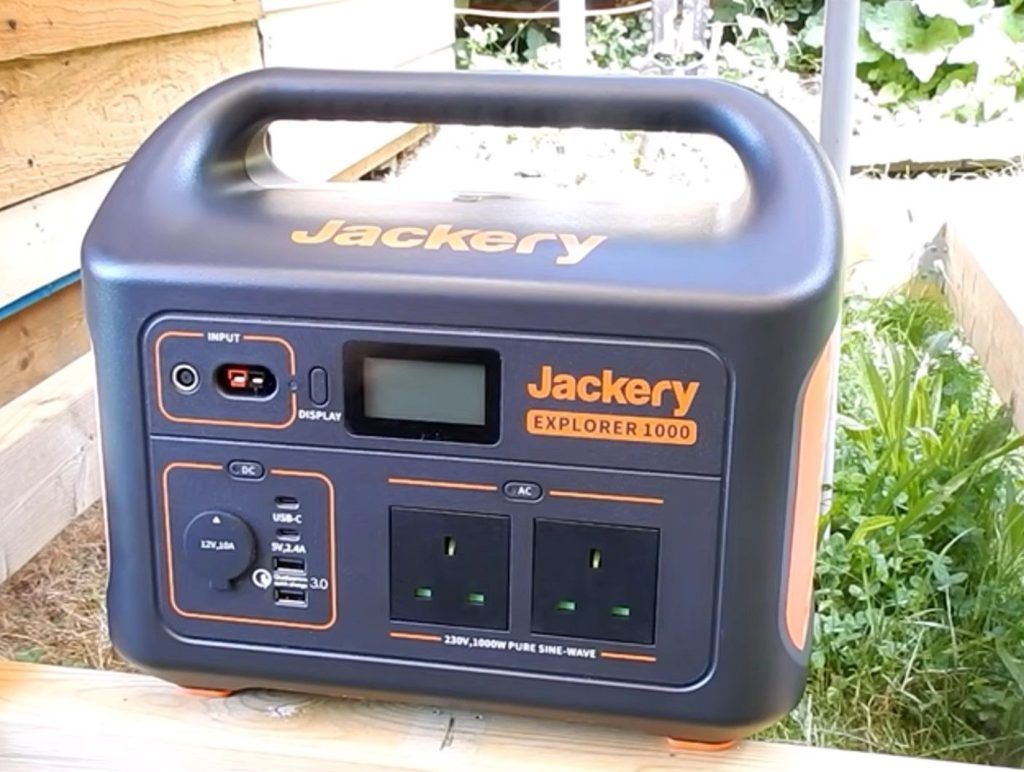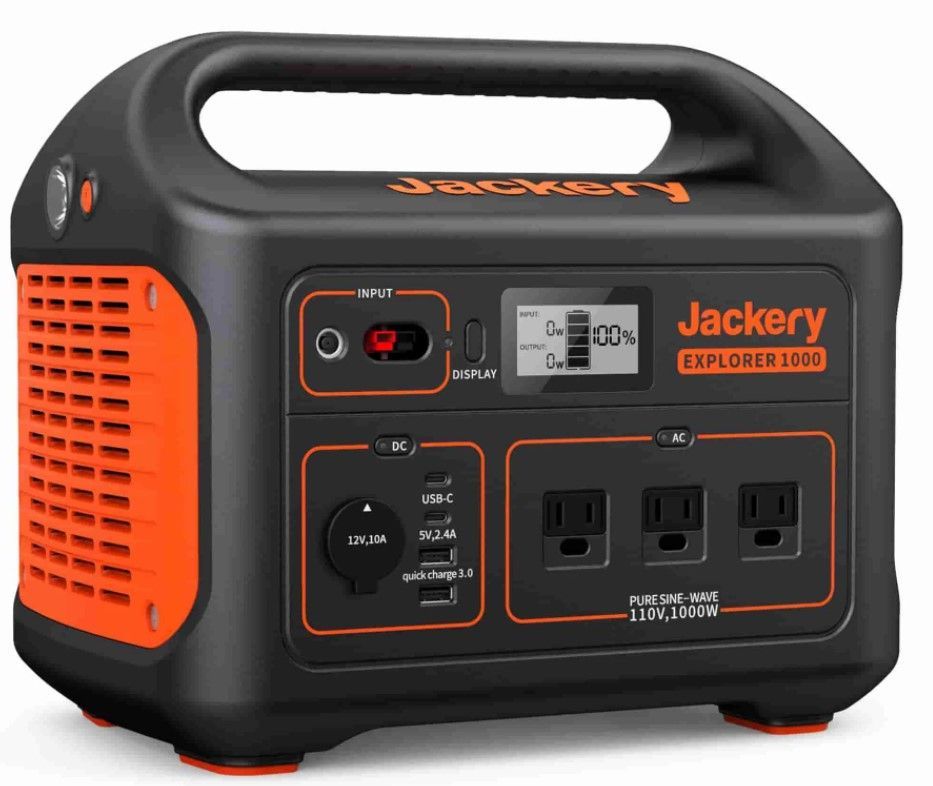EcoFlow Delta 1300 vs Jackery Explorer 1000: It’s not even close

This EcoFlow Delta 1300 vs Jackery Explorer 1000 comparison will help you choose between the two portable power stations for your next outdoor trip. Both these models come from well-reputed brands and are backed with generous warranties. So deciding between them won’t be easy.
In summary, after comparing the EcoFlow Delta 1300 vs Jackery Explorer 1000 I can say that the Jackery 1000 might be a better choice if you’re looking for a lightweight yet reasonably powerful solar generator. Jackery 1000 is also quite a bit cheaper than the Delta 1300. However, if power is your primary concern and you don’t mind lugging around extra pounds or paying more, the EcoFlow Delta 1300 seems to be a no-brainer. This model also offers a higher number of output ports, letting you charge more devices at the same time.
Let’s have a closer look at both these portable power stations.
*The Wild Guides is reader-supported. When you buy through links on my site, I may earn an affiliate commission at no extra cost to you. Learn more*
EcoFlow Delta 1300 Vs Jackery Explorer 1000 – Comparison


EcoFlow Delta 1300 Ratings
- 4.7⭐ out of 244 reviews on REI.com
Here’s how both these portable power stations compare with each other:
Design and Weight
- Winner: Jackery Explorer 1000 (lightweight and compact)
The EcoFlow Delta 1300 weighs 30.9 lbs with the battery pack. Its front panel includes the display and the main power-on switch. The display screen shows how much power is coming in and going out. It also shows the number of charging hours left and the current discharge rate.
Beneath the screen are two rows of ports. Moving from left to right, the first row has two USB-A ports and two USB-A quick-charging ports. The second row has two USB-C ports on opposite ends. Where are the AC and DC ports? They are located on the model’s backside.
Since it has a less powerful battery pack, it shouldn’t come as no surprise that the Jackery Explorer 1000 weighs less heavy than the Eco Flow Delta 1300, at just over 22lbs. Its control panel includes an LED screen, 1x USB-C, 2x USB-A, 3x AC, and 1x DC ports. All of them are front-facing.
Compatible Solar Chargers
- Winner: Eco Flow Delta 1300 (takes less time to go from 0 to 100 percent)
EcoFlow boasts five solar panels in its lineup. These include the EcoFlow 110W, 160W, 400W, 60W, and 220W. Most of them are single-sided. The EcoFlow 220W, meanwhile, lets you use both sides to draw power from the sun’s UV rays.
It is the EcoFlow 110W that is compatible with the Delta 1300. User reviews and my own experience indicate that four of these could take the Delta 1300 from 0 to 100 percent charging in less than four hours, once placed under full sunlight.
Jackery, too, has its own collection of solar panels.
Known as the SolarSaga solar panels, they come in multiple variants, including SolarSaga 60W, 100W, and 200W. Jackery recommends using the SolarSaga 100W for the Explorer 1000. Four pieces of this solar panel will fully charge the Explorer 1000 in 16 hours under bright sunlight.
Battery
- Winner: Eco Flow Delta 1300 (more powerful battery)
The EcoFlow Delta 1300 packs a 1,260Wh Lithium-ion battery. With 13 output ports, this battery station can juice up most household appliances, including refrigerators, microwave ovens, drilling machines, TV, electric saw, and whatnot. No wonder users call the Delta 1300 a compact powerhouse.
As for the Jackery 1000, it comes in with a 1,002Wh Lithium-ion battery. Jackery claims that the battery can retain up to 80% of capacity for the first 500 recharging cycles. That is a low number, especially when compared with that of the Delta 1300, whose battery has an 800 charge life cycle.
That is to say that the Delta 1300’s battery isn’t only more powerful than the Jackery 1000’s. It would also last longer. Also, since the Delta 1300 has a higher number of output ports (more on this later), its battery could charge more devices simultaneously.

Surge Capacity
- Winner: Eco Flow Delta 1300 (higher surge capacity)
Here’s another area where the Delta 1300 shines brighter.
A unit’s surge capacity is the maximum power it can provide for a short time. Surge capacity comes in handy if you intend to operate power-hungry appliances. As the likes of power tools, CPAP machines, and full-size refrigerators need more power at startup than once they’re up and running.
The Delta 1300 boasts a 3,330Wh surge capacity, one-and-a-half-time bigger than Explorer 1000’s (2,000Wh). This makes the Delta 1300 an ideal candidate for operating heavy-duty appliances.
Charging Options and Time
- Winner: Eco Flow Delta 1300 (takes less time to recharge)
The EcoFlow Delta 1300 offers three recharging options. These include an AC wall outlet, EcoFlow 110W Solar Panels, and a 12 V car adapter. Here are the estimated charging times for each option:
- AC Wall Outlet: 1.6 hours
- Solar Panel: 4 hours with four EcoFlow 110W Solar Panels
- 12 V Car Adapter: 10 hours
The Jackery 1000 offers the same number of charging options. However, it would like you to wait for a little longer, whether you opt for a 12V car adapter (14 hours), four SolarSaga 100W Solar Panels (16 hours.), AC wall outlet (7 hours).
Number of output ports
- Winner: Eco Flow Delta 1300
The EcoFlow Delta 1300 comes with 6x AC ports. It also boasts 2x USB-A, 2x USB-A (QC), 2x USB-C, and 1x DC ports. This means this power station is capable of charging 13 devices simultaneously.
The Jackery 1000 lags on this count. While it does offer all the output ports you get with Delta 1300; the number is far lower. This portable power station offers 3x AC ports, 2 USB-A ports, and 1 AC port.
Expansion
- Winner: It’s a tie
You cannot daisy chain either the Jackery 1000 or the Delta 1300. That is to say that you have no choice but to rely on the built-in capacity.
Warranty
- Winner: It’s a tie
Both these models are warrantied for two years.
Price
- Winner: Jackery Explorer 1000 (costs less)
On their official websites, the EcoFlow Delta 1300 and Jackery 1000 are available for $1,399 and $1,099, respectively. This makes the Jackery Explorer 1000 a more cost-effective option.
EcoFlow Delta 1300 Vs Jackery 1000 – Final Verdict
In conclusion, here’s how the EcoFlow Delta 1300 and Jackery 1000 stack up against each other:
- Weight and build: Explorer 1000 is lightweight and far more compact.
- Compatible Solar Chargers: Winner: Eco Flow Delta 1300 (takes less time to go from 0 to 100 percent).
- Charging Options and Time: Winner: Eco Flow Delta 1300 (takes less time to recharge).
- Number of Ports: EcoFlow Delta 1300 wins.
- Battery and Surge Capacity: EcoFlow Delta 1300 is more powerful.
- Warranty: Tie.
- Price: Jackery Explorer 1000 is more budget-friendly.
Portable power station guides
Use this table to find out all the reviews I made about the best portable power stations in the industry.

